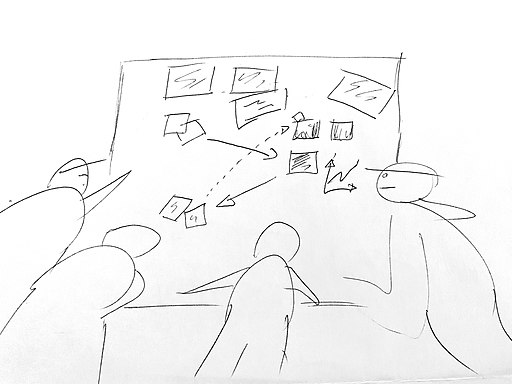Make it so! Decision making in software architecture
I find it interesting in discussions with developers that many have a bad picture of the job of a software architect. When thinking back to my first encounters with a software architect, who was performing his document reviewing job in a dedicated architecture department, I can totally relate, but then again it is 2021 and things should have changed [1]. After all, most developers have a very keen interest that the architecture of the system they are working on is good, but still some developers do not seem to be aware how much their work is impacting the architecture (and vice versa). “Every interesting software-intensive system has an architecture. While some of these architectures are intentional, most appear to be accidental”, as stated in Grady Booch’s article on “Accidental Architecture”. Some people now seem to believe that accidental architecture is the new norm, as “the best architecture, requirements and design emerge from self-organizing teams” (from the principle in the Agile Manifesto). In contrast, in organizations which have dedicated software architects, some people seem to think that it is the architect’s responsibility to ensure that there is a well informed design and to make the hard decisions as necessary. These hard decisions would probably be about “the important stuff (whatever that is)” that is called out in Martin Fowler’s article “Who needs an architect”.
But what does that mean for the daily work, should developers send all questions to the architect for her to make decisions and should architects sit in their ivory tower pondering them and ordering decisions by importance? Not in my view of the world. I’m a big fan of the role model that Fowler describes as Architectus Oryzus or acts as primus inter pares in Georg Hohpe’s article “Agile and Architecture: Friend, not Foe” in which the architect is closely working with the developers and who tries to identify important topics and make sure they are getting addressed at the right time.

Image by Jose Berengueres, CC BY-SA 4.0, via Wikimedia Commons.
Stefan Toth has a fantastic (German only) book on agile processes for software archictecture Vorgehensmuster für Software Architektur which describes patterns how to make this happen in daily practice. The core point of the book is that architecture should be a shared responsibility. Everybody should try to raise and address important concerns — whether there is a dedicated architect role or not is a separate issue. Toth lists patterns like identifying quality scenarios, listing architecture topics in the backlog, ad-hoc architecture meetings, common decision making and testing for architectural concerns (and many more) many of which are very team centric. The book is so great because it shows that it is easy to make architecture work a natural aspect of the development workflow and not some high ceremony.
In my experience, technical discussions are often concerned with architectural topics, so you might not even need to bring people together for formal architecture meetings — nevertheless technical design review meetings can be beneficial if they involve people that can and do share new perspectives but who would otherwise not be working so closely with the team. Similarly, if your team already adds technical debt and other non-functional items into the backlog, you probably are already following two of the recommended practices.
The role of the architect is then not so much the one of a decision maker but more the one of the person taking responsibility that architecture aspects are considered by the team. In bigger organizations this implies that the architect should be working closely with the development team but not only. While ideally the developers are also closely collaborating with any other important stakeholder (product owner, devops / operations, other dev teams), it is quite vital for an architect to understand the different (and potentially conflicting) quality needs of these parties. Again, probably even better than having e.g. 1:1 meetings between architect and security officer, so that the architect can point out operational constraints to the development team, would be if the architect tries to make sure that a security expert is involved in design and requirement discussions.

Image taken from Pixabay
However, the job of an architect is not only consisting of organizing meetings with the right people. In the end, intentional architecture is in need of decisions. “Common decision making”, as listed above, means two things to me: first, people who are affected by a decision (e.g. the developer who has to implement the result) should be directly involved in the decision making process. In teams that do not have a dedicated architect this seems naturally to be the case, but it is worth pointing out that this can easily degrade to single programmer decisions. The other anti-pattern here would be that the architect, likely to be the highest paid person in the room, makes a HiPPO decision or specifies a design while at the same time not being close enough to the problem and / or the existing code base. [2] The effect here can be devastating if the decision turns out to be wrong: not only will people think that the architect did not listen to the team but also that the architect might not have the necessary competence. This can result in serious psychological safety and trust issues. A good working approach to avoid such problems is running small experiments (spikes) to validate options.
The second aspect is that a decision is made in the first place, which is even more important. The idea of decision in the last responsible moment notwithstanding, I find it surprising how hard it can be for organizations / a group of people to take decisions. It is important for an architect to be able to guide a group towards making a decision but also to be comfortable to make a decision themself, if the group cannot find an agreement. The biggest issue here are the trade-offs of potential solutions: e.g., one solution might have benefit A (e.g. scalability) while being weaker in B (e.g. ease of use) and another solution has opposite characteristics. Often different people will have different opinions whether A or B is more important in the selection process. It is very helpful for teams to come to an understanding (not agreement) about these different weighs that people give to the characteristics and then hopefully, the architect can explain why she thinks that one argument is more important than the other. Coming to a decision is more important than convincing everybody, though: aim for solutions that everybody in the team can agree with, even if they would still prefer a different one. Also, it is a good idea to document decisions in a light weight fashion (e.g. in a small Architecture Decision Record).
In case that during implementation the developers run into obstacles, it is quite likely that the developers will actually figure out a different solution than the one decided. This is another case where the “architect as lonely decision maker” can lead to a lot of unnecessary friction. In practice, the choice of a different approach is not a problem as long as it is handled in a similar responsible way, where the developers take a look at the implications and trade-offs of their choice and involve others (and, please, update that ADR).
Footnotes:
[1] I am obviously not talking about so-called Enterprise Architects who are mostly concerned with governing how many systems at a company interact to provide the most business value. Instead the focus here is on software architecture for a single system (which, of course, is likely to interact with many others).
[2] Sometimes the opposite scenario might be true: the team is consisting mostly of people which do not have enough expertise, whereas the architect has long experience with the code base. In this situation, the architect can be helping the team by sketching a design approach and sharing his knowledge. Still, there should be room for questions and further ideas from the team.